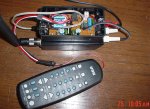OK...I'm back playing with this RF VCR control once again. I have a camera and RF transmitter way down yonder, and I want to start a VCR recording when the transmitter is sending video. To tell the VCR when to record, I tried using serin/serout, and had good results using wires....thanks for the help. I'm almost sure I can't go straight into my A/V transmitter with that though, because it is very loud when connected to an audio input on my TV set... Soooo, back to tones I guess, I know I can use that, and prefer it really.
hippy asked "Would SOUND/PWM/bit-banging for the transmitter and PULSIN/COUNT for the receiver not work for dealing with tone only ?"
Probably so? I am transmitting sound 2,(100,250) ‘ freq 100, length 250, and using an LM567 on the receiver end, and it works great. I have not learned how to use a Picaxe to listen for the sound yet, and I sure want to. Any further help with that would be greatly appreciated
hippy asked "Would SOUND/PWM/bit-banging for the transmitter and PULSIN/COUNT for the receiver not work for dealing with tone only ?"
Probably so? I am transmitting sound 2,(100,250) ‘ freq 100, length 250, and using an LM567 on the receiver end, and it works great. I have not learned how to use a Picaxe to listen for the sound yet, and I sure want to. Any further help with that would be greatly appreciated


![Duncan_and_212__s_VCR_controller_Simplified_pic[1].jpg](/data/attachments/0/852-1b3fb3ca6238161f126cc98cebe38ab1.jpg)


